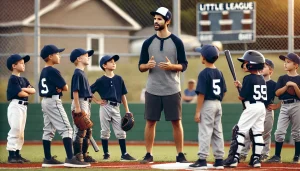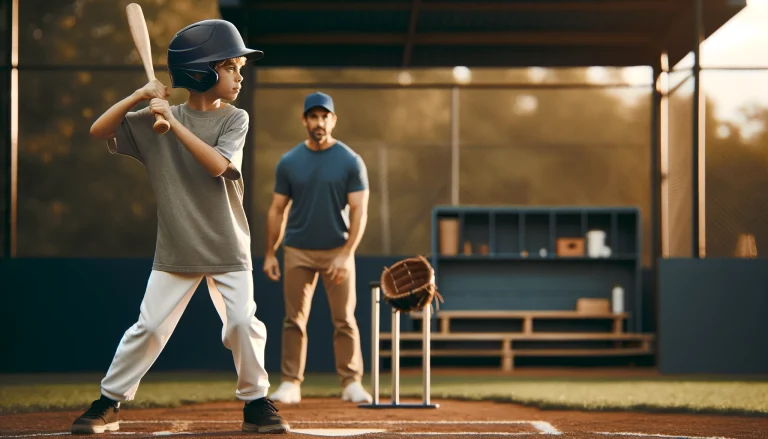Proven Ways to Motivate Young Baseball Players
Introduction
Every Little League coach has witnessed that magical moment—a young player’s face lighting up after their first solid hit or a flawless fielding play.
With the right motivational strategies, you can turn practice from a chore into an adventure.
Let’s dive into proven techniques that keep young athletes excited about baseball!
What Are The Proven Ways to Motivate Young Baseball Players?
Understanding Young Players’ Psychology
Coaching youth baseball isn’t just about skills—it’s about understanding how kids think, learn, and grow at different ages.
Every player brings a unique mix of personality, skill level, and motivations to the field.
Successful coaching means meeting them where they are, both mentally and developmentally.
Age-Appropriate Expectations
Success might mean hitting the ball or running to first base for T-ball players.
At this stage, fun is the priority, with plenty of movement and basic skill introductions to keep them engaged.
Older players, however, face different challenges, from shorter attention spans to increasing comparisons with teammates. Effective coaches tailor their approach to match these shifting needs.
Overcoming Fear of Failure
Fear of failure is a common hurdle in Little League Baseball. Signs include players making excuses to skip practice, claiming sudden illnesses before games, or going quiet during high-pressure moments.
As a coach, it’s your responsibility to create a safe environment where mistakes are seen as learning opportunities. When kids know they won’t be punished for trying something new, they’re likelier to step out of their comfort zones and develop confidence.

The Power of Storytelling
Inspirational stories can resonate deeply with young athletes.
Share age-appropriate examples of professional players who overcame struggles or worked hard to succeed.
These stories remind kids that even their heroes faced challenges—and that setbacks don’t define their potential.
Building a Support System
Coaching doesn’t stop at the field. Partnering with parents ensures a consistent message of positivity, effort, and growth.
Regular communication helps reinforce these values at home, creating a solid foundation for players to thrive mentally and physically.
The ultimate sign of success isn’t just improved performance—it’s a lasting love for the game.
You know you’ve done your job when players tackle new challenges with excitement rather than fear.
By nurturing resilience, confidence, and a passion for baseball, you’re helping young athletes develop skills that will serve them far beyond the diamond.
Creating a Positive Practice Environment
The tone of practice plays a vital role in player development. Young athletes thrive in an atmosphere that combines structured learning with genuine enjoyment.
The best Little League practices are filled with energy, movement, and creativity, ensuring players stay engaged and excited about their progress.
Smart Practice Planning
Effective practices start with thoughtful organization. Divide sessions into smaller segments—no more than 15 minutes per activity for younger players.
Kick off with warm-ups that mimic baseball movements instead of static stretching.
Rotate between skill-building drills and games, and always close with a fun team activity to leave players feeling accomplished.
Use multiple stations to focus on different skills, reducing idle time and keeping the energy up.

Making Drills Fun and Active
Turn traditional drills into interactive challenges. Instead of having one player at bat while others wait, break the team into smaller groups for mini-games.
For instance, set up a pitching station where players compete to hit targets or organize a ground-ball competition.
These small-sided games ensure every player stays active while creating valuable teaching moments.
Encouraging Healthy Competition
Competition is a powerful motivator when approached thoughtfully. Focus on personal improvement over winning and losing.
Challenge players to beat their own records, such as increasing the number of accurate throws or completing more successful fielding plays than the last practice.
This keeps the competitive spirit alive while reducing unnecessary pressure on individual players.
Maximizing Participation
Keep players engaged by using every inch of practice space and incorporating creative drills.
Set up multiple stations, bring extra equipment like balls, tees, and portable bases, and use partner drills to double the chances for skill repetition.
Even players waiting for their turn should stay involved, whether it’s by counting successful plays, giving encouragement, or practicing their form.
Balancing Routine with Variety
Establish a clear routine to give players structure while introducing enough variety to maintain excitement.
Start each practice with a brief team meeting to outline goals and activities, building anticipation for favorite drills or new challenges.
Wrap up by recognizing individual and team achievements, such as improved effort, skill, or attitude.
Adaptability is Key
Weather and field conditions can derail even the best-laid plans, but prepared coaches adapt seamlessly.
Keep indoor alternatives ready—soft toss in a gym or baserunning games in a parking lot can maintain engagement and activity despite outdoor challenges.
Fostering Team Chemistry
As a coach, you play an integral role in fostering team chemistry. Incorporate brief, structured breaks where players can chat and connect.
These moments help build camaraderie and team chemistry while giving kids mental breaks between activities.
Maintaining a balance between bonding and productivity is critical to a cohesive team dynamic, and you have the influence to make it happen.
Individual Recognition and Reward Systems
Recognition in youth baseball requires a thoughtful approach.
While every player appreciates acknowledgment, the focus should remain on personal growth rather than team comparisons.
Effective recognition systems celebrate effort, attitude, and improvement—qualities each player can control.
Setting Personal Goals
Start by understanding each player’s abilities to establish achievable and meaningful improvement targets.
Work one-on-one with players to identify specific, measurable goals.
For example, a budding hitter might aim to make consistent contact with the ball before focusing on power.
At the same time, a young fielder could track successful catches rather than perfect throws.
These individualized goals help players focus on their progress and avoid unhealthy peer comparisons.
Creative Celebrations
Recognition goes beyond simple praise. Introduce special team rituals to celebrate achievements.
For instance, players might earn the right to lead warm-ups, choose the final practice activity, or wear a symbolic team item.
These rewards feel personal and meaningful, emphasizing the joy of improvement without relying on material incentives.
Tracking Progress with Achievement Cards
Use practice achievement cards to provide a tangible record of development.
Design simple cards that track milestones, such as completed drills, successful plays, or mastered techniques.
Players earn marks or signatures for reaching mini-goals during practice.
This visible progress motivates players and helps coaches monitor growth throughout the season.
Weekly Recognition Programs
Expand recognition to highlight a variety of positive behaviors. Instead of naming a single “Player of the Week,” create multiple categories, such as hustle, teamwork, practice attendance, or skill improvement.
This approach ensures more players feel included and reinforces a broader range of desirable qualities.
Documenting Player Progress
Maintain simple notes about each player’s progress, standout moments, and areas of improvement.
These records ensure recognition is distributed evenly and provide specific examples to share with players and parents. Personal details make praise more impactful and genuine.
Beyond Physical Skills
Recognize players for qualities like leadership, sportsmanship, and helping teammates.
These moments emphasize that baseball development isn’t just about athletic ability and character growth. When coaches highlight these traits, players are likelier to embody them consistently.
Involving Parents
Parents play a vital role in supporting recognition systems.
Share specific examples of their child’s progress and effort to help reinforce positive messages at home.
Clear communication ensures parents understand the team’s emphasis on personal growth over raw performance.
Tailored Recognition
Each player responds differently to praise. Some thrive on public acknowledgment, while others prefer quieter, one-on-one feedback.
Understanding these preferences allows coaches to tailor recognition to maximize impact and avoid unnecessary pressure or embarrassment.
Timing Matters
Timing is crucial for effective recognition. Immediate, specific praise during practice reinforces positive behaviors on the spot.
End-of-practice acknowledgments create memorable moments, while weekly or monthly programs offer long-term motivation.
Mixing these timeframes keeps recognition fresh and consistently encouraging.
By creating a system that celebrates effort, improvement, and teamwork, coaches can foster a positive environment where players feel motivated and valued as athletes and individuals.
Building Team Unity and Support
Baseball thrives on team chemistry as much as individual skill.
Young players perform better and enjoy the game more when they feel connected to their teammates.
Building these bonds requires intentional efforts, both on and off the field.
Incorporate Team-Building Activities:
Integrate activities like relay throw challenges or group stretching circles during practice.
These encourage teamwork, communication, and leadership development. Pair experienced players with newer ones in a rotating buddy system, fostering mentorship while ensuring everyone builds connections.

Foster Connections Beyond the Field:
Organize team picnics, local game outings, or pizza parties to allow players to interact without the pressures of performance.
These events help shy players open up and build natural friendships, while parents often forge bonds.
Model Positive Support:
Set clear expectations for encouraging communication. Teach players to cheer for reasonable efforts, offer high-fives, or provide supportive responses after mistakes.
Ban negative comments, replacing them with constructive encouragement.
End practices with a recognition moment, where players highlight how teammates helped them.
Use Team Mantras:
Phrases like “We before me” or “Pick each other up” unite players behind shared values.
Connecting these sayings to actionable behaviors helps players translate the words into teamwork.
Celebrate Team Successes:
Acknowledge team improvements in hustle, communication, or sportsmanship alongside individual achievements.
These small, daily efforts reinforce that team unity is essential for collective success.
Communication Strategies That Work
Effective communication is a cornerstone of successful coaching.
Players respond best to clear, consistent, and age-appropriate messages that resonate with their understanding.
Adapt Feedback to Age:
For younger players, provide simple, immediate feedback focusing on basic movements and effort. For older players, include more detailed instruction and the reasoning behind strategies.
Use demonstrations to complement verbal instructions.
Engage Through Consistent Check-Ins:
Build trust by regularly asking players about their well-being. Simple questions like “How’s school?” or “Are you having fun?” deepen connections and show that you value them beyond their performance.
Communicate with Parents:
Keep parents updated on team progress, player development, and schedules. Address concerns with empathy and clarity, fostering trust and alignment.
Incorporate Multiple Learning Styles:
Combine verbal instructions, visual demonstrations, and hands-on practice to accommodate different learning preferences. Breaking complex skills into small, manageable steps ensures better comprehension.
Game-Based Learning Approaches
Young players learn best when practice feels like play. Game-based learning transforms drills into exciting activities, building skills while maintaining engagement.
Disguise Drills as Games:
Turn fielding practice into “Hot Potato Baseball,” where players must field and throw quickly to score points. Add targets during batting practice to sharpen focus while having fun.
Introduce Mini-Games:
Small-group relay races, hitting contests, or quick competitions encourage repetition and skill development without monotony. Keep groups small to ensure every player stays involved.
Progressive Difficulty:
Start with simple games and gradually add layers of complexity, like time constraints or strategic elements, as players improve. This keeps challenges appropriate and avoids frustration.
Encourage Player Input:
Let players design or modify games. Involving them fosters creativity, ownership, and enthusiasm while tapping into their ideas for fresh challenges.
Managing Playing Time and Positions
Balancing playing time and positions requires fairness, communication, and a focus on development. A structured approach ensures every player feels valued.
Implement a Rotation System:
Clearly communicate your plan before the season, using visual charts to show position rotations and batting orders. Regular tracking prevents oversight and ensures equitable opportunities.
Encourage Positional Exploration:
Use practices to let players try new roles in controlled scenarios. Recognize that early abilities may not predict long-term potential, so keep an open mind.
Strategically Balance Development and Competitiveness:
During non-competitive situations, encourage players to explore new positions. In competitive games, provide brief opportunities for growth while maintaining team strength.
Engage Bench Players:
Assign active roles, such as tracking stats or organizing equipment, to keep benched players connected and involved. Rotate tasks to ensure engagement.
Plan Versatile Practices:
Use station-based drills to expose players to multiple positions. Incorporate defensive scenarios to teach critical skills like bunt coverage or backing up bases.
Communicate with Parents:
Parents should be transparent about rotation policies and provide updates on their child’s progress. They should also address concerns with a focus on development opportunities rather than limitations.
Proven Ways to Motivate Young Baseball Players

Conclusion:
Motivating young baseball players requires a comprehensive approach that balances skill development, positive reinforcement, and, most importantly, fun. The most successful Little League coaches understand that their impact extends beyond teaching baseball fundamentals. By creating supportive environments, recognizing individual progress, building team unity, and implementing engaging practice sessions, coaches help develop better baseball players and more confident, resilient young people.
Remember that every player responds differently to motivation and develops at their own pace. The strategies outlined in this guide serve as starting points – adapt them to fit your team’s unique dynamics and individual player needs. Success in youth baseball isn’t measured solely by wins and losses but by players’ continued enthusiasm for the game and their development as teammates and competitors.
Frequently Asked Questions:
Q: How long should practice sessions last for different age groups? A: T-ball and younger players typically maintain focus for 60-75 minutes. Older Little League players can handle 90-120 minute sessions. Always better to end practice with players wanting more than to drag on too long.
Q: How do I handle parents who question playing time decisions? A: Maintain open communication through regular updates about their child’s development. Document playing time and positions. Schedule private conversations away from game/practice settings to discuss concerns constructively.
Q: What’s the best way to keep practicing fun while developing skills? A: Incorporate game-based learning, maintain fast-paced activities with minimal standing around, and mix competitive challenges with skill development. Keep any one activity under 15 minutes.
Q: How do I manage players with vastly different skill levels? A: Use station-based practices where players can work at appropriate challenge levels. Create buddy systems pairing players of different abilities. Focus on individual improvement rather than comparison with teammates.
Q: When should coaches provide feedback during games? A: Keep game feedback brief and positive. Save detailed instructions for practice sessions. Focus on effort and hustle during games rather than technical corrections.
Q: How can I prevent players from getting discouraged after mistakes? A: Enforce that mistakes are learning opportunities. Create a team culture where effort gets celebrated. Teach specific strategies for bouncing back from errors. Share examples of professional players overcoming challenges.






